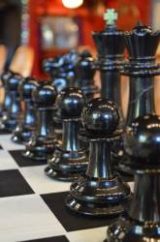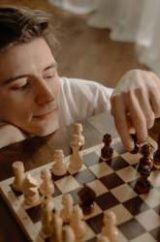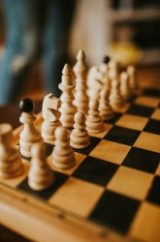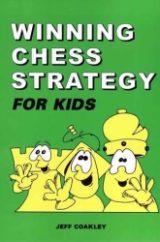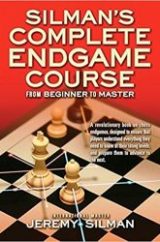Best Books to Learn Chess
| Photo | Title | Rating | Length | Buy |
|---|---|---|---|---|

|
Learn Chess | 8.82/10 | 192 Pages | Check Price On Amazon |

|
Learn Chess Tactics | 9.26/10 | 160 Pages | Check Price On Amazon |

|
101 Chess Opening Traps | 8.78/10 | 112 Pages | Check Price On Amazon |
Learn Chess by John Nunn


 No Prior Knowledge Required
No Prior Knowledge Required
John Denis Martin Nunn is an English chess grandmaster, a three-time world champion, a chess writer and publisher, but also a mathematician. Nunn’s book Learn Chess was published in the year of 2000 and it has since helped thousands of people from around the world learn the most royal of games.
The book begins with the most fundamental of things concerning chess. No knowledge beforehand is a prerequisite, as this book’s main aim is to teach you anything and everything that you need to know so as to become a dominant, successful chess-player.
Step-By-Step
The format of learning is a step-by-step system, as each novel point is aided by illustrations and very clear, concise examples.
By the time that the reader has closed the book for good, he will have become ready to do battle with people from wherever and begin his streak of winning. Genuinely, it is a superb chess book and one of the best books for learning chess if you’re a complete novice. Nunn begins with the mobility and the movements of the pieces, then some chess tricks – a la pin, fork, overload, etc.
Decision Making
The readers will, if nothing more, learn what the correct ways for chess positioning are, how the pieces move and how they ought to attack, how to analyze a check mate, what to do when you are mated, what a stalemate is, special moves and the rules concerning these same moves, etc.
Nunn takes a considerable amount of time discussing and explaining the importance of each of the game phases – the opening, middle game and the endgame – and all of this is coupled with various examples from games played by Grandmasters of chess.
Learn Chess Tactics by John Nunn


 Basics of Chess
Basics of Chess
Learn Chess Tactics is actually a follow-up to Nunn’s Learn Chess. It was published in 2003. While Learn Chess dealt with the most fundamental of things pertaining to chess, Learn Chess Tactics is concerned with teaching the reader about the basics of chess tactics.
John Nunn is a brilliant chess player and a great author, and his books are some of the best books to learn chess, out there. In the Introduction section, Nunn takes his time by explaining to the reader what they’ll be devouring as the pages turn. Take a look at our Learn Chess Tactics book review, if you want to know more.
Tactics
Tactics are defined as a short-term operation, using forcing moves, that aim for an immediate concrete gain. Most of the chess games are decided by tactics. At the higher echelons of the game, long-term strategic thinking is also significant, but even grandmasters utilize short-term tactics. Those playing rapid or blitz chess are helped by the fact that the faster the time-limit, the more that the balance works to the favor of tactics.
Nunn’s advice is that the quickest way for most players to achieve better results is to improve their own tactics. Most players with an ELO of around 1,500 are encouraged to take up the books of Nunn. If you have ELO around 1,500, you might want to check out our article about chess books for intermediate players. Don’t worry! We got something for beginners too!
Plethora of Strategies
Among the various tactics that Nunn discusses, explains and teaches the reader to implement in their own game, are the following – Fork, Discovered Attack, Pin, Skewer, Deflection, Trapped Piece, Removing the Guard, Opening and Closing Lines, Back-Rank Mate, Pawn Promotion, In-Between Moves, there are some defensive tactics, combinations, and they are all helped by a series of miscellaneous exercises.
101 Chess Opening Traps by Steve Giddins


 Guiding Hand
Guiding Hand
Steve Giddins published his 101 Chess Opening Traps book in 1998. Right off the bat, it is worth mentioning that the author, and subsequently the book, doesn’t concern himself with explaining the traps that are being mentioned, but relies on the reader to be able to understand what is happening – this method of having the reader come to the right conclusions with little guide has shown results.
The book, itself, focuses on two main things – traps that can be played with having your own position compromised and traps that are very easy to have an opponent fall into. We got for you excellent books selection if you are interested in chess strategy.
Clever Machinations
The writing of the author is vibrant. With that said, the traps, themselves, are not your run-of-the-mill traps. Even experienced, strong players have been known to fall for these clever machinations. Behind each trap there is an informative background.
Positions that arise during the normal course of the game are chess traps. The most efficient ones are those that arise during a coherent, conspicuous seeming series of moves.
Shortcomings
One of the aspects where the books does fall short is, incidentally, in the educational area. The value that comes with the blunders and mistakes of strong, experienced players, even masters, is a superb one, but it doesn’t help the reader – at least not outright and not in a straightforward, easy to comprehend voice – to learn from these mistakes.
In spite of that, even though complete beginners might not be able to catch Giddins’ drift from the get- go, if they do, they’ll find it a very insightful book. In this manner, we deduce that it is, despite its flaws, one of the best books to learn chess.
Michael Englert
Michael is a graduate of cultural studies and history. He enjoys a good bottle of wine and (surprise, surprise) reading. As a small-town librarian, he is currently relishing the silence and peaceful atmosphere that is prevailing.

